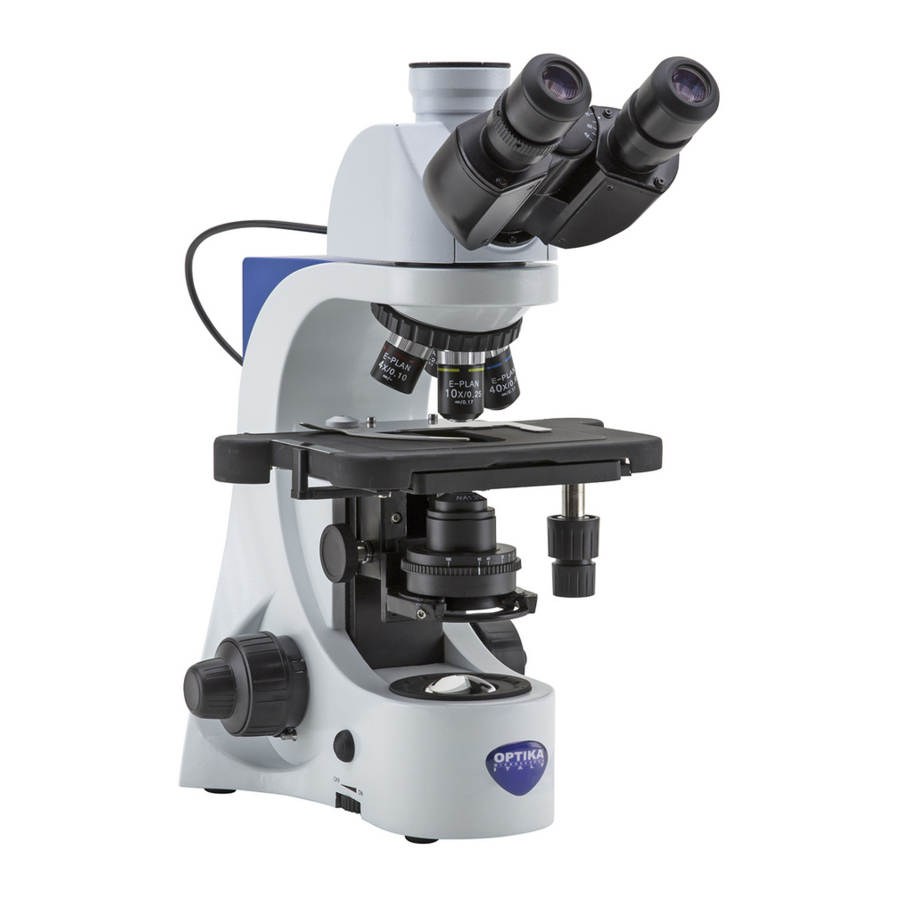
Optika Italy B-380 Serie Manuel D'instructions
Masquer les pouces
Voir aussi pour B-380 Serie:
- Manuel d'instructions (240 pages) ,
- Mode d'emploi (222 pages) ,
- Manuel d'utilisation (168 pages)
Table des Matières
Publicité
Les langues disponibles
Les langues disponibles
Liens rapides
Publicité
Chapitres
Table des Matières

Sommaire des Matières pour Optika Italy B-380 Serie
- Page 1 Ver. 3.0.1 B-380 - B-380ALC OPERATION MANUAL GUIDA UTENTE MANUEL D’INSTRUCTIONS MANUAL DE INSTRUCCIONES BEDIENUNGSANLEITUNG OPTIKA MICROSCOPES - ITALY www.optikamicroscopes.com - info@optikamicroscopes.com...
- Page 26 SOMMAIRE 1.0 DESCRIPTION pag. 27 2.0 INTRODUCTION pag. 29 3.0 DÉBALLAGE ET MONTAGE DU MICROSCOPE pag. 30 4.0 UTILISATION DU MICROSCOPE pag. 31 4.1 Réglage de la tête d’observation 4.2 Positionnement de la préparation sur la platine 4.3 Réglage du système d’éclairage 4.4 Réglage de la distance inter pupillaire 4.5 Réglage de la mise au point 4.6 Réglage de la compensation dioptrique...
-
Page 27: Description
1.0 DESCRIPTION SORTIE PHOTO VIDÉO RÉGLAGE DE LA DISTANCE INTER PUPILLAIRE OCULAIRES VIS DE FIXATION DE LA TÊTE (1) RÉVOLVER OBJECTIFS SURPLATINE MÉCANIQUE COMMANDES COAXIALES DIAPHRAGME À IRIS (3) CONDENSEUR VIS DE RÉGLAGE DE CONDENSEUR (2) AJUSTEMENT LUMINOSITE (CÔTÉ GAUCHE) ECLAIRAGE LED Page 27... - Page 28 1.0 DESCRIPTION RÉGLAGE DE LA DISTANCE INTER PUPILLAIRE PINCE POUR MAINTENIR LES PRÉPARATIONS RÉGLAGE DE LA HAUTEUR DU CONDENSEUR COMMANDE DE MISE AU POINT MICROMÉTRIQUE COMMANDE DE MISE AU POINT COMMANDE DE MACROMÉTRIQUE RÉGLAGE DE TENSION VERROUILLAGE DU FOYER Page 28...
-
Page 29: Introduction
2.0 INTRODUCTION Ce microscope est un appareil scientifique de précision pensé pour durer de nombreuses années avec un entretient minimum. Pour son élaboration il a été utilisé des éléments optiques et mécaniques de grande qui le convertisse en un appareil idéal pour une utilisation journalière dans les salles de classes et les labora- toires. -
Page 30: Déballage Et Montage Du Microscope
3.0 DÉBALLAGE ET MONTAGE DU MICROSCOPE Le microscope est livré dans un emballage en polystyrène. Après avoir sortie l’emballage en polystyrène de son carton, enlevez la partie supérieure en enlevant de l’emballage en ayant enlevé au préalable la bande adhésive qui se trouve tout au tour. Faites bien attention de ne pas endommager les composants optiques (objectifs et oculaires) et évitez que l’appareil ne tombe. -
Page 31: Utilisation Du Microscope
4.0 UTILISATION DU MICROSCOPE Votre microscope est un instrument de laboratoire conçu por durer longtemps. Traitez le avec soin et évitez de le soumettre à chocs et vibrations. Débranchez toujours le câble d’alimentation quand le microscope n’est pas utiliser pendant longtemps, lors du nettoyage ou lorsque que vous en effectuez l’entretien. -
Page 32: Réglage De La Compensation Dioptrique
4.0 UTILISATION DU MICROSCOPE Réglage de la compensation dioptrique Tourner l’anneau de réglage dioptrique sur l’oculaire gauche jusqu’à atteindre la position zéro. Enle- vez la vis qui fixe le bouton de l’ouverture de mise au point et desserrez le bouton. Faites la mise au point de la préparation en tournant la commande micrométrique et en utilisant l’objectif le plus faible. - Page 33 4.0 UTILISATION DU MICROSCOPE Choisir l’objectif 10x en tournat le revolver. Tourner la tourelle du condenseur jusqu’à ce que vous voyez l’inscription “10”. Régler la mise au point de l’anneau lumineux que vous observez en dessérant la vis du télescope de centrage.
-
Page 34: Contrôle Automatique De La Lumière (Modèles B-382Alc)
5.0 CONTRÔLE AUTOMATIQUE DE LA LUMIÈRE (MODÈLES B-382ALC) Les modèles B-382-ALC ont une fonction spéciale appelée “Contrôle automatique de la lumière”. Le niveau de lumière est réglé par le microscope pour maintenir le même niveau que celui que l’uti- lisateur a choisi, n’importe si l’ouverture du diaphragme change, si un autre objectif est inséré, si l’opacité... -
Page 35: Entretient Du Microscope
6.0 ENTRETIEN DU MICROSCOPE Environnement pour utilisation Il est conseillé d’utiliser ce microscope dans un environnement propre et sec, il faut aussi éviter les chocs. La température recommandée pour travailler est entre 0 et 40°C et l’humidité relative maxi- male conseillée est de 85 % (sans condensation). Si cela est nécessaire, utilisez un déshumidifiant. Conseils avant et après l’utilisation du microscope - Pendant les déplacements, gardez le microscope en position verticale, et faite bien attention que les accessoires mobiles ne tombent pas, comme par exemple les oculaires. -
Page 36: Recyclage Et Récupération
7.0 RECYCLAGE ET RÉCUPÉRATION Conformément à l’Article 13 du D.L du 25 Juillet 2005 nº151 Action des Directives 2002/95/CE, 2002/96/CE et 2003/108/CE, relatives à la réduction de l’utili- sation de substances dangereuses dans l’appareil électrique et électronique et à l’élimination des résidus. -
Page 39: Descripción
1.0 DESCRIPCIÓN SALIDA PHOTO / VIDEO ANILLO DE AJUSTE DE DIOPTRÍAS OCULARES TORNILLO DE BLOQUEO DEL CABEZAL (1) REVÓLVER PORTAOBJETIVOS OBJETIVOS PLATINA PORTAPREPARADOS MANDOS COAXIALES DE DESPLAZAMIENTO DE LA DIAFRAGMA IRIS (3) PLATINA CONDENSADOR TORNILLOS DE CENTRADO DEL CONDENSADOR (2) AJUSTE BRILLO (A LA IZQUIERDA) - Page 40 1.0 DESCRIPCIÓN DISTANCIA INTERPUPILAR PINZA DE SUJECIÓN DE MUESTRAS MANDO DE REGULACIÓN DE LA ALTURA DEL CON- DENSADOR (4) MANDO DE ENFOQUE MICROMÉTRICO MANDO DE ENFOQUE MACROMÉTRICO REGULACIÓN DE LA TENSIÓN (5) BLOQUEO DEL MANDO DE ENFOQUE Página 40...








